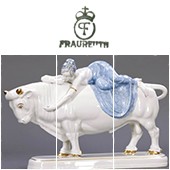Fraureuth Porcelain

Hardly any manufactory looks back on such an interesting history as the production site in Fraureuth: The porcelain produced here reflects both the transformation of the place and a centuries-long family tradition:
When the entrepreneur Georg Beck, originally from Greiz, sought to develop new production areas during the course of industrialization, his choice fell on the Saxon settlement of Fraureuth. However, producing porcelain or having objects made from it designed was far from his mind. The Thuringian had his eye on the numerous existing spinning and weaving mills in the area. Consequently, under his leadership, a centrally located wool combing mill was established, which was put into operation in 1802.
Despite the economic success that the facility achieved, Beck's grandson Georg Bruno Foedisch showed no interest in taking it over. He pursued his own plans and left his hometown of Fraureuth. Producing porcelain was also not on his mind; however, he accidentally stumbled upon the opportunity to acquire this well-guarded secret.
After Foedisch was able to deepen and consolidate his relevant skills, he returned in 1865 to the site of his childhood. Now, porcelain was to be produced in the former wool combing mill in Fraureuth. In cooperation with the manor owner Arved von Römer, the previous site developed into the "Porzellanfabrik Römer & Foedisch" named after the founders.
While the residents of Fraureuth looked over the shoulders of porcelain makers from Bohemia, the thwarted wool comber continuously expanded the factory premises and extended it to more than 73,000 m². In the year of his death, around 600 workers were busy meeting the steadily increasing sales of Fraureuth porcelain.
In 1891, Foedisch's widow converted the company into a joint-stock company and supplemented it with numerous social facilities. At her initiative, a painting school, a canteen, a savings bank, a hospital, and a fire station with its own water connection were established in the vicinity of the Fraureuth Porcelain Factory. The majority share of the thus upgraded company went to the merchant Felix Singer in 1913.
Under his leadership, Fraureuth porcelain was created, whose colors, shapes, and decors were rated as "outstandingly beautiful" at the Leipzig Autumn Fair of 1916. An assessment that numerous buyers agreed with and which made the company's products a coveted export hit. Especially overseas, the high-quality and aesthetically pleasing Fraureuth porcelain found brisk sales.
After the acquisition of the Thuringian manufactory "Wallendorf" in 1919, the factory expanded its range. From then on, figurative sculptures and other objects not exclusively intended for daily use were also produced under the "Fraureuth Porzellan" brand. This did not detract from the success - on the contrary: The products of Fraureuth Porzellan AG continued to be in high demand and enabled the company to undertake new social projects.
However, in the mid-1920s, the rampant inflation took its toll: Felix Singer resigned from his position as General Director of "Fraureuth Porzellan" and dismissed all employees of the main and subsidiary plants.
But the closed-down manufactory was able to preserve its good reputation. To this day, Fraureuth porcelain is considered among connoisseurs as an exceptionally beautiful and pleasantly simple designed product that regularly fetches high sums at auctions. We also buy figures or tableware parts in your possession at fair prices. Please contact us for this via the known communication channels.





 Exclusive offers 10 € voucher when you sign up to our newsletter.
Exclusive offers 10 € voucher when you sign up to our newsletter.








